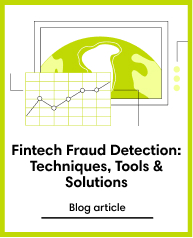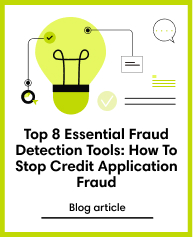Fraud
Oct 19, 2021
How can financial institutions better avoid fraud?
Subscribe to our newsletter
Financial institutions have become smarter and more efficient with their processes in recent years all thanks to technologies such as artificial intelligence, cloud, big data, and more. And with the COVID-19 pandemic stimulating the rapid shift of consumers towards convenient digital solutions, banks and other financial institutions have integrated financial technology into their systems. Data shows that 50 per cent of consumers now interact with their bank through mobile apps or websites at least once a week, compared to 32 per cent two years ago.
But as financial institutions improve their products and services, scammers and fraudulent customers also become better with their illicit agendas. In 2020, more than $1 trillion was lost globally to cybercrime, with high fraud rates affecting fintech players among other hard-hit industries. In the United States, more than 1.8 million loans distributed under the government’s COVID-19 business assistance program were identified with indications of potential fraud that borrowers initiate. About 960,000 of the said loans came through new online lenders.
This then begs the question: how can financial institutions better avoid fraud in the digital age? Below are some of the ways that they can protect themselves from fraud and losses.
Educate employees about fraud detection
In a world where digital solutions are entering the mainstream, humans are still reliable sources of help and defence when it comes to financial transactions. It’s for this reason that employees in financial institutions should also learn how to detect fraud when dealing with customers. Employees should have an adequate, if not advanced, understanding of API fraud, stolen or fake cards, website cloning, ATM fraud, and other forms of finance-specific scams to be able to easily detect them.
Moreover, it helps financial institutions to identify where different types of fraud will most likely occur, as well as qualify risks based on the overall exposure they might face. As an additional step, they should retrain employees on fraud detection and prevention every few months or so to increase organisational awareness and maintain a high level of vigilance when it comes to fraudulent customers and transactions.
Beware of internal fraud
In some cases, fraudulent activities become successful when people from the inside help scammers with their plans. Financial institutions should implement careful hiring practices, background checks, and a checks-and-balances workflow to detect malicious employees and stop fraud on the onset.
As for existing employees, financial institutions should be aware of potential fraudsters on every level of the employee hierarchy. Research from KPMG International shows that 34 per cent of internal fraudsters are executives or non-executive directors, which goes to show that people in power have just as much motivation to commit illegal activities.
Employ fraud detection systems
Financial institutions have come a long way from manually processing transactions and verifying customer identities to relying everything on technology. But for those who have yet to start their digital transformation, it pays for them to invest in artificial intelligence- or machine learning-backed systems such as bank statement analysers, multi-factor authentication, biometrics, and transaction monitoring dashboards, among other things. With these technologies, financial institutions stand a chance at assessing masses of data and investigating processes, transactions, and malicious activities better and faster.
There are thousands of fintech innovations available in the market today that help financial institutions better detect fraud. Credolab’s Fraud SDK product, for instance, helps lenders and other financial institutions identify fraudulent borrowers even at the beginning of the lending process. It generates fraud scores within seconds as a way of indicating good and reliable loan applicants from bad ones, helping lenders save time and effort when processing credit or loans.
Contact other financial institutions
While this step may take up more time and manual effort, it does add another level of security when it comes to assessing customers and processing financial transactions. Similar to how job applicants can place fake credentials and experiences to make their resumes look more attractive to potential employers, scammers and fraudulent customers can tamper with bank statements, pay stubs, and other financial documents they are required to show to prove their financial capabilities.
Fraudsters are also capable of stealing identities to get their way. For instance, two Americans were charged with fraud in 2020 for applying for more than $500,000 in small business loans to fund four fake businesses. One of the suspects allegedly used his brother’s personal identifying information to make real estate transactions as well. No matter how tedious the process is, contacting banks and other institutions to conduct background checks can prevent fraud on the onset.
Improve cybersecurity measures
The finance sector is not new to cybercrime but it still suffers from millions of losses every year due to illegal online activities. A BAE Systems Applied Intelligence report showed that 74 per cent of organisations in the finance sector have experienced a rise in cybercrime since the pandemic began, with 42 per cent of banks and insurers feeling less secure because of the remote working model.
With fraudsters and cybercriminals revealing network or infrastructure holes, financial institutions are at risk of falsely assessing transactions and losing customers. They should then improve their cybersecurity systems and measures to better identify a threat and stop it before it does any damage.
As more banks, lenders, and other institutions rely on fintech players to accelerate and improve their operations, they should also apply effective measures to protect themselves and their customers. Illicit activities in the finance sector show no signs of going away, especially as more and more people aim to fulfil their selfish agendas, but it pays to remain aware of them and prepare action plans to stop them.





